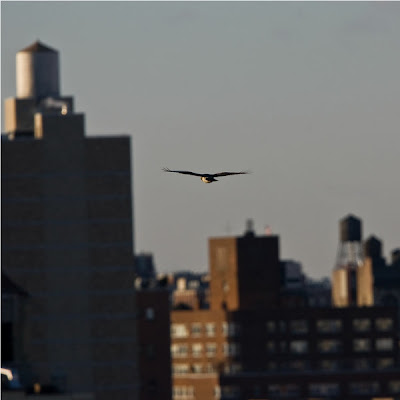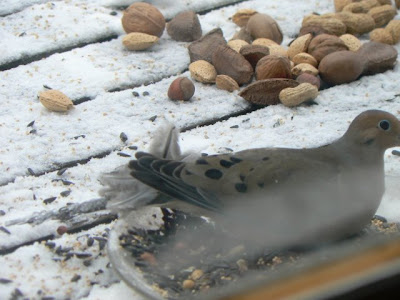
Steam, the tiercel of Thresherman's Park, Wisconsin, with several feet of snow on the ground perches high in an oak beside the highway...

...and hunts in 16 below zero weather.

Screen Captures Courtesy of KJRH TV Tulsa
Hi, Donna:
We Tulsa Forum folk are musing over an occurrence today at the KJRH nest site.
Jay showed up at the nest this afternoon with a prey item, perhaps a rodent. In a span of about 7 or 8 minutes, he flew in with the little critter, mantled briefly over it in the nest, picked at it a bit, and then flew off with it.
Very shortly, both Kay and he flew back in, the prey still in Jay's possession. Both hawks huddled over it very briefly in the nest, heads down; and then Kay exited, soon followed by Jay.
We aren't sure who had final possession of the prey. We have not seen prey in the nest since Thunder was still visiting the Tower. We are wondering what, if any, significance this event might have had, especially in the context of anticipated courting behavior.
A gesture from Jay to Kay, perhaps? (It may or may not be relevant that Tulsa has for two days been experiencing bitterly cold weather.)
I'm attaching two photos of this brief interlude.
By the way, the two sycamore pods of recent interest are still in the nest, and we have noted their having been moved from time to time as the nest rebuilding continues.Any thoughts?
Jackie (Tulsa Hawk Forum)
Photos attached:
1. Jay with prey
2. Kay (foreground) and Jay huddling over prey
3. sycamore pods still in nest today, 1-16

Cheryl,
It looks to me that what you have here is a Jay giving Kay a courtship gift. (As Marie Winn of www.mariewinn.com/ has been known to remind at this point, Gentleman pay attention.)
This may be what is going on. First Jay brings his gift for Kay to the nest and mantle's it. Kay doesn't appear so he picks up his present and flies over to where she can see it, possibly flying back and forth in front of her if he wishes her to go with him to the nest, instead of presenting it to her where she's presently perched.
Kay follows Jay to the nest, they check out the present. If the female isn't hungry at that moment the male will stash the gift for her to eat later. Later in the season, the presentation of a gift can lead to copulation on the spot. Interesting that the nuptial gift is a mammal. It seems to me, perhaps keeping track of the species of gifts this season would help us decide if my unsubstantiated thought is true in the various locales, that mammals are given in a higher percentage of the time as gifts then are birds for gifts. Pigeons in most urban locations tending toward the most prevalent day to day menu item.
If anyone is on the ground near the site they might be seeing courtship flights going on in conjunction with the gifts.

Well there are those Sycamore fruits. Interesting. It looks almost like the birds are using them as some kind of specific nest device. It would be interesting if a few more appeared in mirroring the positions of the current fruit.
LAMENTS OF PHOTOGRAPHER RAPTOR WATCHERS
From chief watcher of Southern Central Park, Pale Male Junior and Charlotte--
Hey Donna.
You won't believe how upset I am. I brought my camera into work
both Wednesday and Thursday since I had seen Charlotte and Junior several times
on Tuesday thinking that I would definitely see them together.
They never showed up together either day. I did get a few photos of Charlotte on the Essex House building and I got a few photos of US Airways 1549 in the water. Then
Today [Friday] both Jr. and Charlotte visited the nest together several times and of course I didn't have my camera. Oh well. I'm going to try to go in one day this
weekend and see if I can get some photos of them together.
Brett Odom
It NEVER fails!
I faithfully try to carry at least a baby Nikon, having been burnt on this issue far too many times. On Monday, I had to run out to grab a few groceries before yet another snowstorm. Well, I look up just as I'm passing over the river and there...RIGHT THERE...flying over me and toward a near by copse of trees, where it then perched big as life, was a mature Bald Eagle. No camera.
**********************************************************************************
And from R. of Illinois, Today's Go Get 'Em Moment
http://www.ktla.com/content_landing_page/?Great-Dane-Helps-Foil-Robbery=1&blockID=185415&feedID=1080

(Sent in by Karen Anne Kolling) From the inimitable icanhascheezburger.com:
Donegal Browne




























